Социальная программа «Шаг в будущее, Электросталь - 2015»
Исследовательская работа
Тема: “Extraordinary Houses Around the World”
Номинация: Иностранный язык
(номинация: «Шаг в будущее, Юниор»).
(Социо-культурный аспект)
Работу выполнили:
Ученики 5 класса МОУ «Гимназия №9»
Каримов Илья, Шабалов Артем
Руководитель:
Каримова Виктория Вячеславовна,
учитель английского языка
г.о. Электросталь
2015
Contents
About Us
Introduction
The House-Shifter, Poland
Nautilus House, Mexico City
Hundertwasser House, Vienna, Austria
The Flintstones Stone House, Portugal
The Crooked House, Sopot, Poland
The Cube Houses, Rotterdam, Netherlands
Het Potlood (The Pencil-house), Rotterdam, Netherlands
Reversible-Destiny Lofts, Japan
The Underground Houses, Switzerland
The Bubbled House, Cannes, France
Conclusion
Literature
About us
My name is Karimov Ilia. I am a pupil of the form 5. I am 11 years old and I like 3D modeling very much. I have a big collection of 3D towers. Look at them. In addition, I am interested in computer modeling, especially design of houses and flats. In the future I want to become an architect.
My name is Shabalov Artem. I am eleven and I am a pupil of the form 5. I am fond of making Lego and sometimes I build unusual houses and even towns. That`s why this theme is very interesting for us. We also like travelling and go sightseeing.
Introduction
This work can be useful and attractive for learning English, especially for schoolchildren of elementary grades. The object of our study is the art and architecture of different countries. At an English lesson while learning the topic “East, West, Home`s best” we got interested in unusual houses. We wanted to know more about extraordinary houses around the world: their history, the origin of their names, reasons of their popularity, their difference from other buildings and etc. We have worked hard both on the language and on the cultural aspect of our theme. It was not easy because we have been learning English only for 5 years. We had to find out a lot of information from the Internet. Our achievement is important for ourselves, our classmates and for our English teacher.
We got interested:
if there are extraordinary houses all over the world;
why they are so popular and unusual;
which of them are the most extraordinary and why;
what they look like inside and outside.
The House-Shifter, Poland
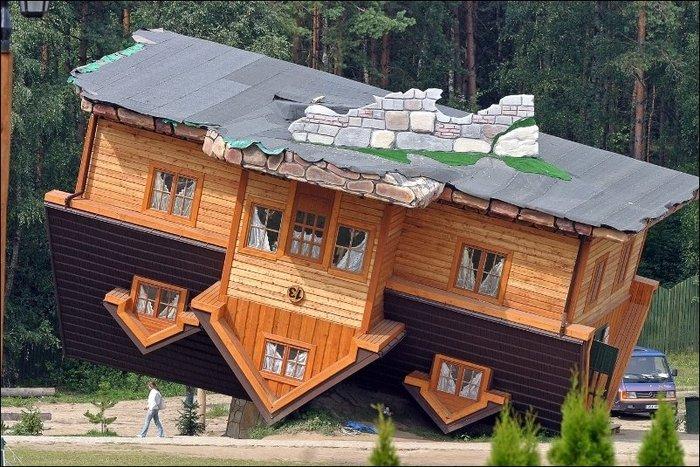
Although the house - shifters exist in many countries of the world,
Polish house attracts a lot of tourists.
It is situated in a tiny village Szymbark .The author of the project is the artist, architect Daniel Chapevski. It was originally planned to build a house for 3 weeks, but the construction lasted 114 days because they wanted to build a stable house, so that you can live in it.
The house-shifter looks very realistic - the roof is down, "foundation", "grass" and "land" are on the top. The entrance to the house is through the attic window, and inside the house everything is upside down.
Many architects come to see the unusual house and get inspiration and new ideas from it. And most of the tourists after visiting this extraordinary house, complain of sickness, nausea and a headache because many feel that they are upside down, and not the house. But it is a normal reaction of the human body to be present upside down.
All visitors at the outlet of the unusual house are offered a glass of water, which can help to deal with all discomfort. But still there are no people who would like to buy it and live there.
Nautilus House, Mexico City
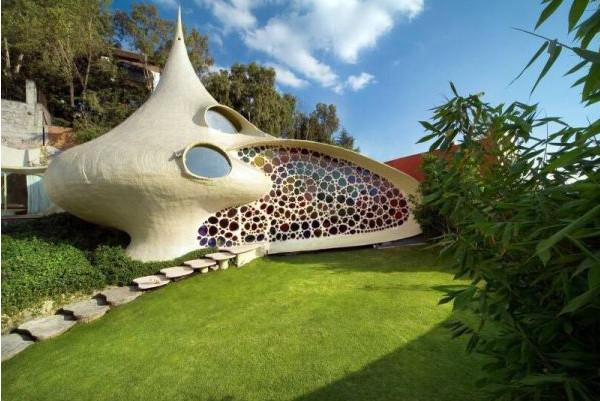
Imagine living in a hose in the shape of a seashell. In Mexico City there is a house like that. The architect of the house is Javier Senosian. He is sure that nature is the only source of inspiration. We should watch it and it can give us a lot of new ideas.
It is called Nautilus because the shape of the house and everything inside look like habitats of sea creatures. It was built in 2006 by the company “Arquitectura ORGANICA”.
A young couple with two children live there. It is an extraordinary house because the space isn`t limited and you can feel the unity with nature. This house is decorated in a very colourful and optimistic style and it gives only positive emotions. It`s really amazing!
Hundertwasser House, Vienna, Austria
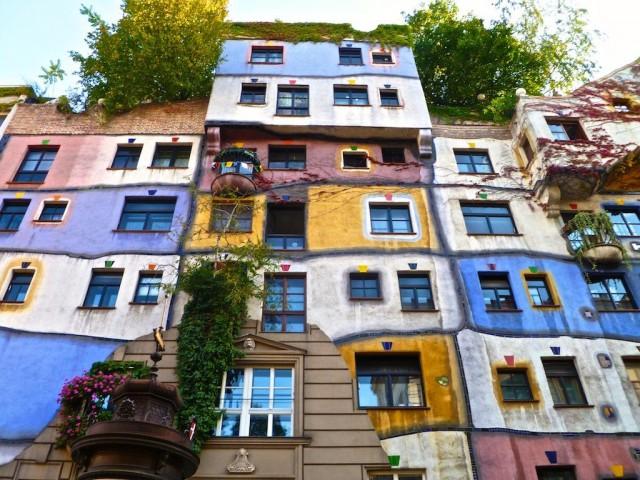
Hundertwasser house is popular with tourists. It was built in 1986. It is hard to believe that the customer of this project were the authorities of Vienna, however, this building was to become the model for construction of other residential and municipal buildings in the city.
The architect wanted to express how the individuality of each person is important for a modern society. For this reason, the building is divided in colours. Hundertwasser wanted every resident of the house to paint himself the area around his window.
In addition, the architect considered windows one of the most important components of the external appearance of the house, that`s why eight different types of windows of different sizes were used.
The second important idea the author considered is the idea of the unity of man and nature. Therefore, when designing the house he used natural motifs, such as grass and shrubs, trees, applications on the walls in the form of birds and animals. And uneven floor resembles the mountain trails or forest trails. However, the house meets all the standards of fire safety and other requirements.
There are 50 flats in this house. There is a fountain in the center of the yard, a café, a garden, a parking and a playground.
The Flintstones Stone House, Portugal
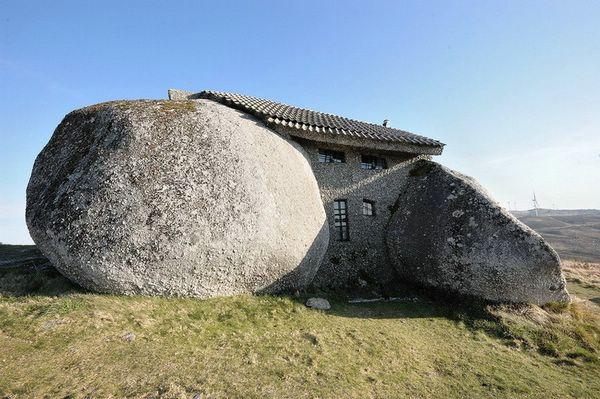
We all know the cartoon about a little family of Flintstones, who lived in prehistoric houses made of stone.
In real life a house of stones also exists. Not far from the city of Fafe, in Portugal, a Portuguese Victor Rodriguez built this impressive house in 1973. It was built in huge stones, covered with moss and they became its walls. An asymmetric window gives this house a cartoony look. One side of the roof is lined with tiles, while the other side has a flat slope. Nevertheless, in the house there is a fireplace and a staircase with railings made of logs, and near the house there is a stone barn and an outdoor pool.
The last ten years the house is empty because of the unusual construction. The house attracts a lot of tourists from different countries. Therefore, the owners left the house.
The Crooked House, Sopot, Poland
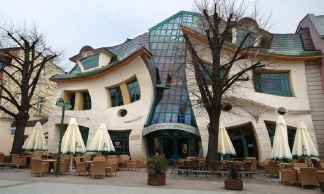
In 2004, in Sopot, Poland, a fantastic building was built, which combines the art world and the world of business. It is better known as The Crooked House.
Firstly, the construction of a shopping center was planned in this tourist street, and of course, the building was to be ordinary. However, the Swedish artist Per Dahlberg, who has been charged a sketch project, was inspired by the famous Polish illustrator of fairy tales, Jan Marcin Szansera. He wanted to create something fabulous.
Now this shopping center has become one of the main attractions of the city and many tourists are willing not only to take a picture on the background, but also buy a souvenir there. There are many shops and a restaurant on the first floor and there is a radio studio on the second one.
The Crooked House was recognized as the best architectural design at the "Great Dreamers Contest”.
Cube Houses, Rotterdam, Netherlands
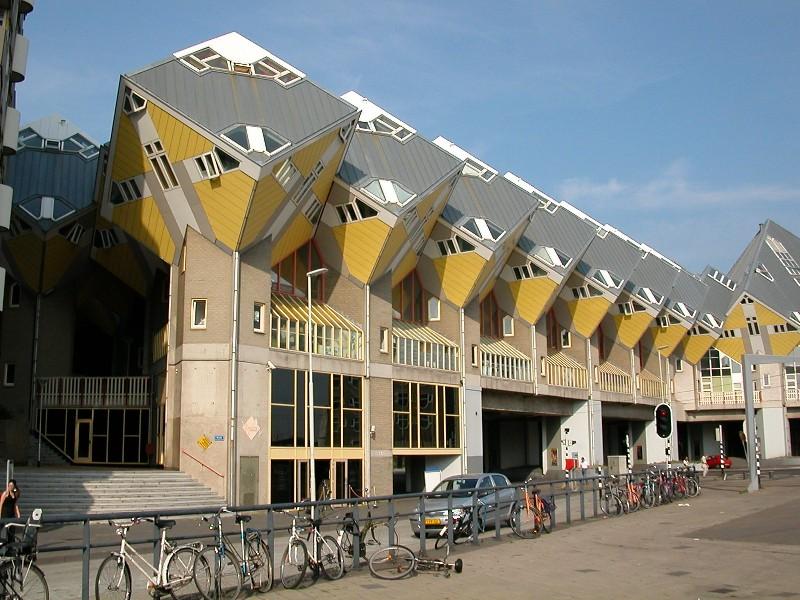
Cube houses in the street Oude Haven in Rotterdam are the most illustrative example of modern architecture in the Netherlands. These unique buildings were built in the period between 1978 and 1984 by the architect Piet Blom. In his projects Piet Blom used the idea of abstract trees, and, thus, its residential complex turned into a forest, and the street Blaakse Bos appeared. It was important to create a kind of “a city in a city”, with shops, schools and playgrounds.
38 cube houses are standing on the top. There is the entrance and stairwell at the concrete foot. A wooden cube is divided into three levels: Street house (a kitchen and a living room), Heavenly house (a bedroom) and Green house (a room for the garden). Windows, located in the diagonally sloping walls, are large. It provides a connection between private (upper level) and public (lower level).
Kijk-Kubus is a fully equipped, but it isn`t residential flat-museum (Show Cube), located in the street Blaakse Bose. It has a special interior which helps visitors to feel the atmosphere of life in a cubic house. The flat- museum is open daily from 11:00 to 17:00.
The complex of cubic flats is a pedestrian bridge. The bridge connects the city center and a residential area. To attract pedestrians to use this bridge for crossing the street Blaake with its heavy traffic, Peet Blom had to give the bridge an unusual architectural form. Dutch architect managed to achieve the optimal combination of form, function and beauty.
Of course, people live in these amazing houses with glass roofs. There are also shops, a school, a restaurant and a hostel Stayokay Rotterdam Cube Hostel, where there are 46 rooms and you can stay there and try living in this cube house.
Het Potlood (Pencil-house), Rotterdam
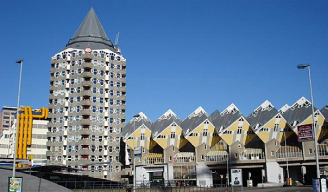
A block of flats of extraordinary architecture was built in 1984. It was designed by Peter Blom, the author of cubic houses in Rotterdam. This building has a shape of a sharpened pencil. There is a house next to it and people call it “a rubber”.
Along with "cubic houses " this structure creates an incredibly interesting architectural ensemble, without which it is hard to imagine a modern look of Rotterdam.
This pencil-house is much better suitable for life than cubic houses in which the walls and floor are located under unusual angle.
Reversible-Destiny Lofts, Japan

In the suburbs of Tokyo in 2002-2006 9-apartment residential complex was built. Although outside the Complex Reversible- destiny lofts looks quite finished, inside you can find some unfinished and unusual things.
Living in these houses is a permanent examination for survival, even the passage between the rooms is not only an amazing journey, but it is also very extreme. Every room is unique here, for example, walls have 40 different colors and made of different materials. The floors are not normal: in some places the surface is convex, in other places it is concave. The doors are also curved, switches and outlets are situated in remote places. There are no bathrooms in the house, they were not included in the project. The architect thinks that permanent solution to domestic difficulties promotes longevity and stimulate the immune system. Despite high prices of these flats, they are in great demand.
Underground Houses, Switzerland
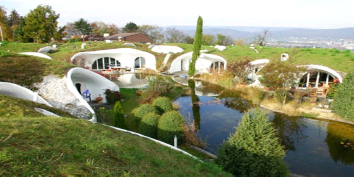
This is an unusual underground houses, peek out from under layers of green, do not look like real buildings, but more like fabulous.
The designers of the company Vetsch Architektur decided to use the land as a material for construction. Now this land blanket protects buildings from the weather, such as rain, wind, temperature and aging. Nine houses are located around the lake. During daylight hours, the rooms are lit by natural light thanks to the well-engineered zoning. Bedrooms are located in the north side of the buildings, while the living rooms are in the south. There are stairs to the basement and bathrooms between them. Bathrooms have horizontal windows, so they are illuminated by natural light as well. Despite the fact that the first floor is built on the principle of dugouts, the underground parking and the cellar are made using the latest technologies. People plant grass and even edible plants on the green rooftops.
Bubbled House, Cannes, France
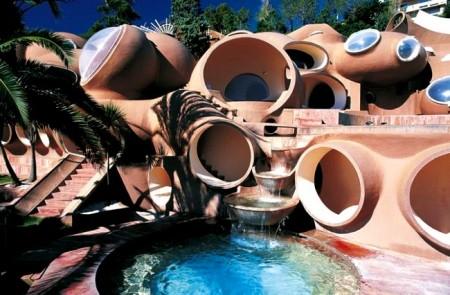
A French fashion designer Pierre Cardin is a distinguished fashion designer. His house, located in Cannes, is very extraordinary.
The history of "Bubbled house" began in the 80s. Pierre Cardin wanted to buy a house on the French Riviera. His attention was focused on the house for a French capitalist. After the death of the entrepreneur, Cardin bought the construction site and together with the architect Antti Lovag, who supports the ideas of organic architecture, was inspired by the natural forms and images. He transformed the house into such an unusual "bubbled" construction.
It is a dream house and absolutely individual. It was built in the French Riviera. The house is completely built without corners. It is similar to a hill of soap bubbles, poured on the coast from a vial with shampoo. This architecture resembles natural biological forms in contrast with a normal geometry of houses. It is often called organic architecture. The house is bubbled inside: round rooms and windows, bubbled yards and terraces facing the sea, bubbled swimming pools. A pink color of the house makes it more impressive.
Conclusion
We`ve told you only about ten the most unusual and weird houses. Why do people build them? There are different reasons. Some people build their dream houses, others construct natural houses, others invest money and want to be eccentric. Who knows? Maybe, in the future we`ll design and build a new extraordinary house! In Russia!
Literature
http://en.wikipedia.org
http://ru.wikipedia.org
Longman Dictionary of English Language and Culture.
Cambridge International Dictionary of English.

 Получите свидетельство
Получите свидетельство Вход
Вход



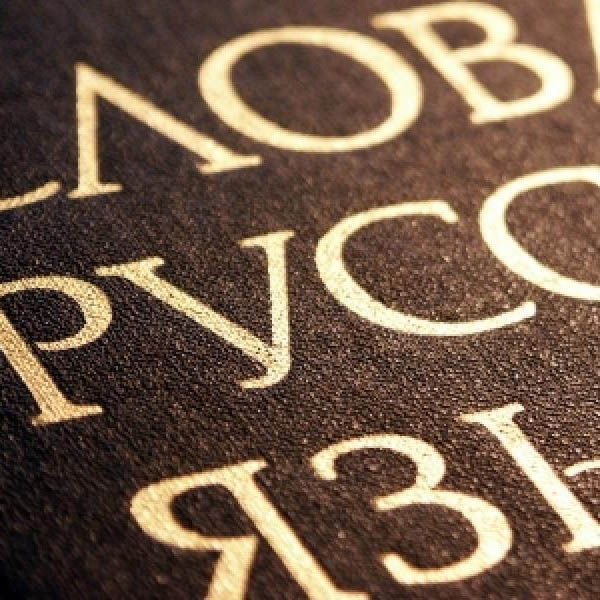
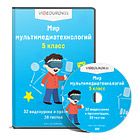







 Исследовательская работа-проект "Extraordinary Houses Around the World" (2.81 MB)
Исследовательская работа-проект "Extraordinary Houses Around the World" (2.81 MB)
 0
0 401
401 2
2 Нравится
0
Нравится
0




